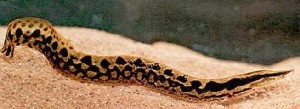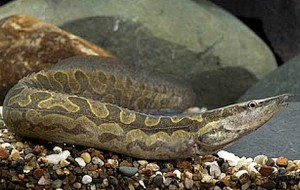The Tire Track Eel (Mastacembelus armatus) is native to the rivers and streams of India, Pakistan, Sumatra, Sri Lanka, Thailand, Viet Nam, Indonesia and other parts of South East Asia. They are also known to tropical fish keeping enthusiasts as the Zigzag eel, Spiny Eel, Leopard Spiny Eel, Marbled Spiny Eel, Giant Spiny Eel, Giant Mottled Eel, Car Track Spiny Eel, and White Spotted Spiny Eel.
Although the Tire Track Eel is a popular aquarium fish in Europe and the United States, they are regarded as a food fish in their native countries.
Tire Track Eels are a nocturnal predator species that are members of the Mastacembelidae family, which are not true eels. They thrive in still waters, highland streams, lowland wetlands, coastal marshes, and highly vegetated rivers with sandy or rocky riverbeds. In the rainy season during the summer months, they can be found in canals, lakes, and other areas of the flooded plains.
Tire Track Eels are a large elongated snake like fish that are devoid of pelvic fins. Their anal and dorsal fins are elongated and connected to their caudal fin and numerous spines can be found just before their dorsal fin.
They are colored a dark beige along the back with a silver beige head. The body is colored a dull brown with a lighter shade of brown on the belly. Circular brown patterns mark the body along with one to three darker longitudinal zig zag lines that connect to form a distinctive reticulated pattern along the dorsal two thirds of their body. Brown stripes run laterally through the eyes of the fish. Adult female Tire Track Eels are plumper than males but indistinguishable as juveniles.
The Tire Track Eel should be keep in a large single species aquarium of at least 100 gallons with a sand or fine gravel substrate, some driftwood, rock work in the form of caves, and some potted or floating plants
. Because they are fond of digging into the substrate and burying themselves, they will uproot plants and quickly rearrange any decorations in the tank.
They should not be kept with smaller fish that they might consider a meal but can be housed with other large species. They are commonly kept in a community aquarium environment with knifefish, danios, medium to large gouramis, loaches, Loricariids, eartheaters, acaras, Cichlasomines, and Asian catfish. Adding 2 teaspoons of aquarium salt for every 2 1/2 gallons of tank water is beneficial to this species.
Tire Track Eels have never been bred in an aquarium environment and although they reproduce abundantly in the wild, there are no known successful breeding programs.
As a nocturnal carnivore, Tire Track Eels feed on benthic insect larvae, earthworms, blackworms, and occasionally on submerged plant material in their natural environment. In an aquarium environment, they should be fed live, frozen, or freeze dried foods such as live fish, tubifex worms, brine shrimp, ghost shrimp
, mosquito larvae, bloodworms
, cyclops, krill, or even ocean plankton.
Tire Track Eels are wild caught and available to tropical fish keeping enthusiasts online and seasonally from specialty specialty shops when they are 3″ to 6″ in size.
Minimum Tank Size: 125 gallons
Care Level: Moderate
Temperament: Semi Aggressive
Aquarium Hardiness: Hardy
Water Conditions: 72-82° F, KH 10-16, pH 6.8-7.2
Max. Size: 2′6″
Color Form: Brown, Tan
Diet: Carnivore
Compatibility: Single species tank
Origin: Southeast Asia
Family: Mastacembelidae
Lifespan: 8-19 years
Aquarist Experience Level: Intermediate





